老鐵們,是時候燥起來了!本文中我們將學習如何使用 SwiftUI 中的 Paths 和 AnimatableData 來制作顏色切換動畫。

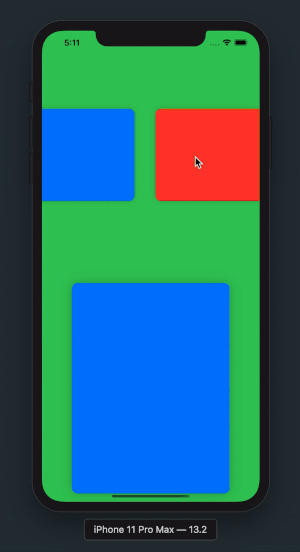
這些快速切換的動畫是怎么實現的呢?讓我們來看下文吧!
基礎
要實現動畫的關鍵是在 SwiftUI 中創建一個實現 Shape 協議的結構體。我們把它命名為 SplashShape 。在 Shape 協議中,有一個方法叫做 path(in rect: CGRect) -> Path ,這個方法可以用來設置圖形的外觀。我們就用這個方法來實現本文中的各種動畫。
創建 SplashShape 結構體
下面我們創建一個叫做 SplashStruct 的結構體,它繼承于 Shape 協議。
|
1
2
3
4
5
6
7
8
|
import SwiftUIstruct SplashShape: Shape { func path(in rect: CGRect) -> Path { return Path() }} |
我們首先創建兩種動畫類型: leftToRight 和 rightToLeft ,效果如下所示:

Splash 動畫
我們創建一個名為 SplashAnimation 的 枚舉 來定義動畫類型,便于以后更方便地擴展新動畫(文章末尾可以驗證!)。
|
1
2
3
4
5
6
7
8
9
10
11
12
13
|
import SwiftUIstruct SplashShape: Shape { public enum SplashAnimation { case leftToRight case rightToleft } func path(in rect: CGRect) -> Path { return Path() }} |
在 path() 方法中,我們可以選擇需要使用的動畫,并且返回動畫的 Path 。但是首先,我們必須創建變量來存儲動畫類型,記錄動畫過程。
|
1
2
3
4
5
6
7
8
9
10
11
12
13
14
15
16
|
import SwiftUIstruct SplashShape: Shape { public enum SplashAnimation { case leftToRight case rightToleft } var progress: CGFloat var animationType: SplashAnimation func path(in rect: CGRect) -> Path { return Path() }} |
progress 的取值范圍在 0 和 1 之間,它代表整個動畫的完成進度。當我們編寫 path() 方法時,它就會派上用場。
編寫 path() 方法
跟之前說的一樣,為了返回正確的 Path ,我們需要明確正在使用哪一種動畫。在 path() 方法中編寫 switch 語句,并且用上我們之前定義的 animationType 。
|
1
2
3
4
5
6
7
8
|
func path(in rect: CGRect) -> Path { switch animationType { case .leftToRight: return Path() case .rightToLeft: return Path() }} |
現在這個方法只會返回空 paths。我們需要創建產生真實動畫的方法。
實現動畫方法
在 path() 方法的下面,創建兩個新的方法: leftToRight() 和 rightToLeft() ,每個方法表示一種動畫類型。在每個方法體內,我們會創建一個矩形形狀的 Path ,它會根據 progress 變量的值隨時間發生變換。
|
1
2
3
4
5
6
7
8
9
10
11
12
13
14
15
16
17
18
19
|
func leftToRight(rect: CGRect) -> Path { var path = Path() path.move(to: CGPoint(x: 0, y: 0)) // Top Left path.addLine(to: CGPoint(x: rect.width * progress, y: 0)) // Top Right path.addLine(to: CGPoint(x: rect.width * progress, y: rect.height)) // Bottom Right path.addLine(to: CGPoint(x: 0, y: rect.height)) // Bottom Left path.closeSubpath() // Close the Path return path}func rightToLeft(rect: CGRect) -> Path { var path = Path() path.move(to: CGPoint(x: rect.width, y: 0)) path.addLine(to: CGPoint(x: rect.width - (rect.width * progress), y: 0)) path.addLine(to: CGPoint(x: rect.width - (rect.width * progress), y: rect.height)) path.addLine(to: CGPoint(x: rect.width, y: rect.height)) path.closeSubpath() return path} |
然后在 path() 方法中調用上面兩個新方法。
|
1
2
3
4
5
6
7
8
|
func path(in rect: CGRect) -> Path { switch animationType { case .leftToRight: return leftToRight(rect: rect) case .rightToLeft: return rightToLeft(rect: rect) }} |
動畫數據
為了確保 Swift 知道在更改 progress 變量時如何對 Shape 進行動畫處理,我們需要指定一個響應動畫的變量。在 progress 和 animationType 變量下面,定義 animatableData 。這是一個基于 Animatable 協議 的變量,它可以通知 SwiftUI 在數據改變時,對視圖進行動畫處理。
|
1
2
3
4
5
6
7
|
var progress: CGFloatvar animationType: SplashAnimationvar animatableData: CGFloat { get { return progress } set { self.progress = newValue}} |
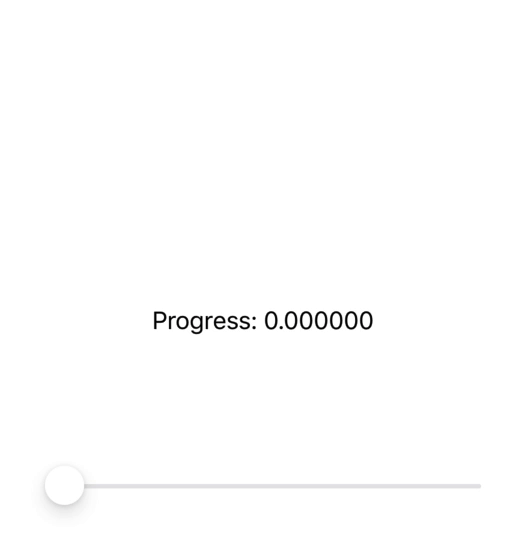
顏色切換時產生動畫
到目前為止,我們已經創建了一個 Shape ,它將隨著時間的變化而變化。接下來,我們需要將它添加到視圖中,并在視圖顏色改變時自動對其進行動畫處理。這時候我們引入 SplashView 。我們將創建一個 SplashView 來自動更新 SplashShape 的 progress 變量。當 SplashView 接收到新的 Color 時,它將觸發動畫。
首先,我們創建 SplashView 結構體。
|
1
2
3
4
5
6
7
8
|
import SwiftUIstruct SplashView: View { var body: some View { // SplashShape Here }} |
SplashShape 需要使用 SplashAnimation 枚舉作為參數,所以我們會把它作為參數傳遞給 SplashView 。另外,我們要在視圖的背景顏色變化時設置動畫,所以我們也要傳遞 Color 參數。這些細節會在我們的初始化方法中詳細說明。
ColorStore 是自定義的 ObservableObject。它用來監聽 SplashView 結構體中 Color 值的改變,以便我們可以初始化 SplashShape 動畫,并最終改變背景顏色。我們稍后展示它的工作原理。
|
1
2
3
4
5
6
7
8
9
10
11
12
13
14
15
16
17
18
19
20
21
22
23
24
25
26
|
struct SplashView: View { var animationType: SplashShape.SplashAnimation @State private var prevColor: Color // Stores background color @ObservedObject var colorStore: ColorStore // Send new color updates init(animationType: SplashShape.SplashAnimation, color: Color) { self.animationType = animationType self._prevColor = State<Color>(initialValue: color) self.colorStore = ColorStore(color: color) } var body: some View { // SplashShape Here }}class ColorStore: ObservableObject { @Published var color: Color init(color: Color) { self.color = color }} |
構建 SplashView body
在 body 內部,我們需要返回一個 Rectangle ,它和 SplashView 當前的顏色保持一致。然后使用之前定義的 ColorStore ,以便于我們接收更新的顏色值來驅動動畫。
|
1
2
3
4
5
6
7
|
var body: some View { Rectangle() .foregroundColor(self.prevColor) // Current Color .onReceive(self.colorStore.$color) { color in // Animate Color Update Here }} |
當顏色改變時,我們需要記錄 SplashView 中正在改變的顏色和進度。為此,我們定義 layers 變量。
|
1
|
@State var layers: [(Color,CGFloat)] = [] // New Color & Progress |
現在回到 body 變量內部,我們給 layers 變量添加新接收的 Colors 。添加的時候我們把進度設置為 0 。然后,在半秒之內的動畫過程中,我們把進度設置為 1 。
|
1
2
3
4
5
6
7
8
9
10
11
12
|
var body: some View { Rectangle() .foregroundColor(self.prevColor) // Current Color .onReceive(self.colorStore.$color) { color in // Animate Color Update Here self.layers.append((color, 0)) withAnimation(.easeInOut(duration: 0.5)) { self.layers[self.layers.count-1].1 = 1.0 } }} |
現在在這段代碼中, layers 變量中添加了更新后的顏色,但是顏色并沒有展示出來。為了展示顏色,我們需要在 body 變量內部為 Rectangle 的每一個圖層添加一個覆蓋層。
|
1
2
3
4
5
6
7
8
9
10
11
12
13
14
15
16
17
18
19
20
21
22
|
var body: some View { Rectangle() .foregroundColor(self.prevColor) .overlay( ZStack { ForEach(layers.indices, id: \.self) { x in SplashShape(progress: self.layers[x].1, animationType: self.animationType) .foregroundColor(self.layers[x].0) } } , alignment: .leading) .onReceive(self.colorStore.$color) { color in // Animate color update here self.layers.append((color, 0)) withAnimation(.easeInOut(duration: 0.5)) { self.layers[self.layers.count-1].1 = 1.0 } }} |
測試效果
你可以在模擬器中運行下面的代碼。這段代碼的意思是,當你點擊 ContentView 中的按鈕時,它會計算 index 來選擇 SplashView 中的顏色,同時也會觸發 ColorStore 內部的更新。所以,當 SplashShape 圖層添加到 SplashView 時,就會觸發動畫。
|
1
2
3
4
5
6
7
8
9
10
11
12
13
14
15
16
17
18
19
20
21
22
23
24
25
|
import SwiftUIstruct ContentView: View { var colors: [Color] = [.blue, .red, .green, .orange] @State var index: Int = 0 @State var progress: CGFloat = 0 var body: some View { VStack { SplashView(animationType: .leftToRight, color: self.colors[self.index]) .frame(width: 200, height: 100, alignment: .center) .cornerRadius(10) .shadow(color: Color.black.opacity(0.2), radius: 10, x: 0, y: 4) Button(action: { self.index = (self.index + 1) % self.colors.count }) { Text("Change Color") } .padding(.top, 20) } }} |

還沒有完成!
我們還有一個功能沒實現。現在我們持續地把圖層添加到 SplashView 上,但是沒有刪除它們。因此,我們需要在動畫完成時把這些圖層清理掉。
在 SplashView 結構體 body 變量的 onReceive() 方法內部,做如下改變:
|
1
2
3
4
5
6
7
8
9
10
11
|
.onReceive(self.colorStore.$color) { color in self.layers.append((color, 0)) withAnimation(.easeInOut(duration: 0.5)) { self.layers[self.layers.count-1].1 = 1.0 DispatchQueue.main.asyncAfter(deadline: .now() + 0.5) { self.prevColor = self.layers[0].0 // Finalizes background color of SplashView self.layers.remove(at: 0) // removes itself from layers array } }} |
這行代碼能讓我們刪除 layers 數組中使用過的值,并確保 SplashView 基于最新更新的值顯示正確的背景色。
展示成果!

GitHub 源碼
您可以在我的 Github 上查看本教程的源代碼 !除了顯示的示例外,還包括 SplashShape 和 SplashView 的完整源代碼。 ....但是等等,還有更多!
彩蛋!
如果你熟悉我之前的教程,你應該了解我喜歡彩蛋 :wink:。在本文開頭,我說過會實現更多動畫。此刻終于來了…… 擊鼓 ……。
Splash 動畫
哈哈哈!!還記得嗎?我說過會添加更多動畫種類。
|
1
2
3
4
5
6
7
8
9
10
11
12
13
14
15
16
17
18
19
20
21
22
23
24
25
26
|
enum SplashAnimation { case leftToRight case rightToLeft case topToBottom case bottomToTop case angle(Angle) case circle}func path(in rect: CGRect) -> Path { switch self.animationType { case .leftToRight: return leftToRight(rect: rect) case .rightToLeft: return rightToLeft(rect: rect) case .topToBottom: return topToBottom(rect: rect) case .bottomToTop: return bottomToTop(rect: rect) case .angle(let splashAngle): return angle(rect: rect, angle: splashAngle) case .circle: return circle(rect: rect) }} |
你肯定會想…… “哇, 彩蛋也太多了……” 。不必苦惱。我們只需要在 SplashShape 的 path() 方法中添加幾個方法,就能搞定。
下面我們逐個動畫來搞定……
topToBottom 和 bottomToTop 動畫
這些方法與 leftToRight 和 rightToLeft 非常相似,它們從 shape 的底部或頂部開始創建 path ,并使用 progress 變量隨時間對其進行變換。
|
1
2
3
4
5
6
7
8
9
10
11
12
13
14
15
16
17
18
19
|
func topToBottom(rect: CGRect) -> Path { var path = Path() path.move(to: CGPoint(x: 0, y: 0)) path.addLine(to: CGPoint(x: rect.width, y: 0)) path.addLine(to: CGPoint(x: rect.width, y: rect.height * progress)) path.addLine(to: CGPoint(x: 0, y: rect.height * progress)) path.closeSubpath() return path}func bottomToTop(rect: CGRect) -> Path { var path = Path() path.move(to: CGPoint(x: 0, y: rect.height)) path.addLine(to: CGPoint(x: rect.width, y: rect.height)) path.addLine(to: CGPoint(x: rect.width, y: rect.height - (rect.height * progress))) path.addLine(to: CGPoint(x: 0, y: rect.height - (rect.height * progress))) path.closeSubpath() return path} |

circle 動畫
如果你還記得小學幾何知識,就應該了解勾股定理。 a^2 + b^2 = c^2
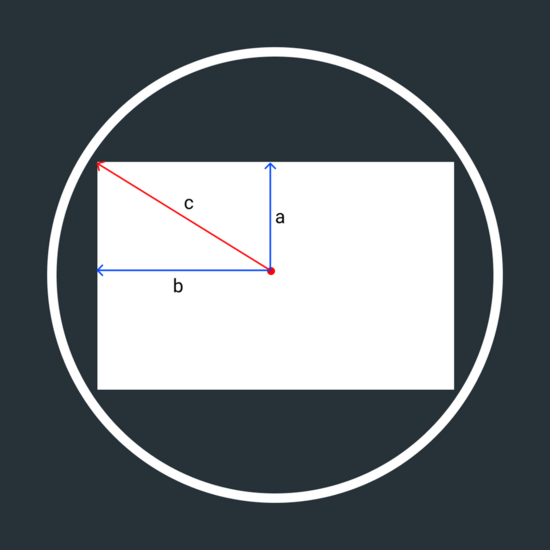
a 和 b 可以視為矩形的 高度 和 寬度 ,我們能夠根據它們求得 c ,即覆蓋整個矩形所需的圓的半徑。我們以此為基礎構建圓的 path,并使用 progress 變量隨時間對它進行變換。
|
1
2
3
4
5
6
7
8
9
10
11
12
13
|
func circle(rect: CGRect) -> Path { let a: CGFloat = rect.height / 2.0 let b: CGFloat = rect.width / 2.0 let c = pow(pow(a, 2) + pow(b, 2), 0.5) // a^2 + b^2 = c^2 --> Solved for 'c' // c = radius of final circle let radius = c * progress // Build Circle Path var path = Path() path.addArc(center: CGPoint(x: rect.midX, y: rect.midY), radius: radius, startAngle: Angle(degrees: 0), endAngle: Angle(degrees: 360), clockwise: true) return path} |
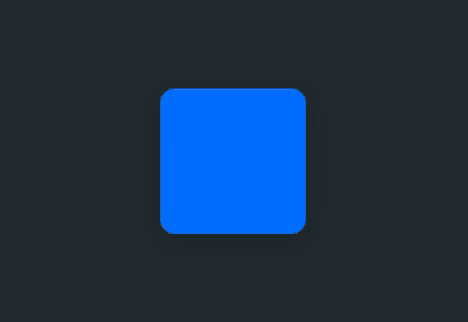
angle 動畫
這個動畫知識點有點多。你需要使用切線計算角度的斜率,然后根據這個斜率創建一條直線。在矩形上移動這條直線時,根據它來繪制一個直角三角形。參見下圖,各種彩色的線表示該線隨時間移動時,覆蓋整個矩形的狀態。
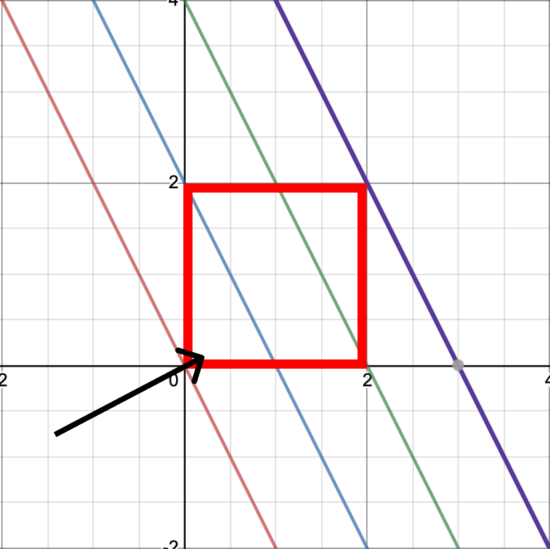
方法如下:
|
1
2
3
4
5
6
7
8
9
10
11
12
13
14
15
16
17
18
19
20
21
22
23
24
25
26
27
28
29
30
31
32
33
34
35
36
37
38
39
40
41
42
43
|
func angle(rect: CGRect, angle: Angle) -> Path { var cAngle = Angle(degrees: angle.degrees.truncatingRemainder(dividingBy: 90)) // Return Path Using Other Animations (topToBottom, leftToRight, etc) if angle is 0, 90, 180, 270 if angle.degrees == 0 || cAngle.degrees == 0 { return leftToRight(rect: rect)} else if angle.degrees == 90 || cAngle.degrees == 90 { return topToBottom(rect: rect)} else if angle.degrees == 180 || cAngle.degrees == 180 { return rightToLeft(rect: rect)} else if angle.degrees == 270 || cAngle.degrees == 270 { return bottomToTop(rect: rect)} // Calculate Slope of Line and inverse slope let m = CGFloat(tan(cAngle.radians)) let m_1 = pow(m, -1) * -1 let h = rect.height let w = rect.width // tan (angle) = slope of line // y = mx + b ---> b = y - mx ~ 'b' = y intercept let b = h - (m_1 * w) // b = y - (m * x) // X and Y coordinate calculation var x = b * m * progress var y = b * progress // Triangle Offset Calculation let xOffset = (angle.degrees > 90 && angle.degrees < 270) ? rect.width : 0 let yOffset = (angle.degrees > 180 && angle.degrees < 360) ? rect.height : 0 // Modify which side the triangle is drawn from depending on the angle if angle.degrees > 90 && angle.degrees < 180 { x *= -1 } else if angle.degrees > 180 && angle.degrees < 270 { x *= -1; y *= -1 } else if angle.degrees > 270 && angle.degrees < 360 { y *= -1 } // Build Triangle Path var path = Path() path.move(to: CGPoint(x: xOffset, y: yOffset)) path.addLine(to: CGPoint(x: xOffset + x, y: yOffset)) path.addLine(to: CGPoint(x: xOffset, y: yOffset + y)) path.closeSubpath() return path} |

總結
到此這篇關于SwiftUI使用Paths和AnimatableData實現酷炫的顏色切換動畫的文章就介紹到這了,更多相關SwiftUI 顏色切換動畫內容請搜索服務器之家以前的文章或繼續瀏覽下面的相關文章希望大家以后多多支持服務器之家!
原文鏈接:https://juejin.im/post/5eb39472e51d454dae5575cd













